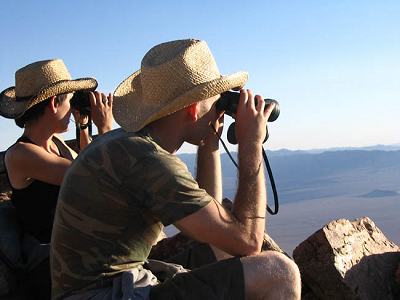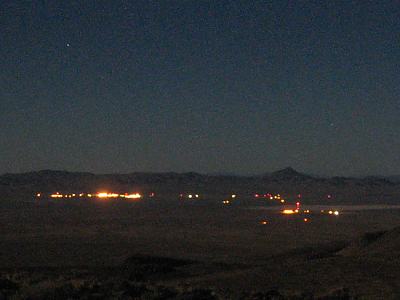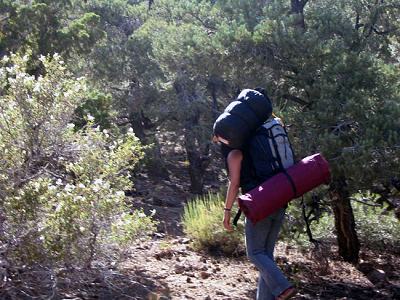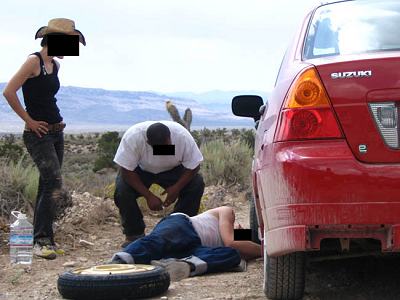 On the Friday morning of July 30th, 2004, I brought seven people on a three-day expedition to look at two “secret bases” in the Nevada desert. It was the first in a series of planned expeditions to secret military facilities in the West.
On the Friday morning of July 30th, 2004, I brought seven people on a three-day expedition to look at two “secret bases” in the Nevada desert. It was the first in a series of planned expeditions to secret military facilities in the West.
 On the Friday morning of July 30th, 2004, I brought seven people on a three-day expedition to look at two “secret bases” in the Nevada desert. It was the first in a series of planned expeditions to secret military facilities in the West.
On the Friday morning of July 30th, 2004, I brought seven people on a three-day expedition to look at two “secret bases” in the Nevada desert. It was the first in a series of planned expeditions to secret military facilities in the West.
We assembled in Oakland during the cold, grey Bay Area morning, and I passed out the guide books that I’d written for this trip. The idea was that people could learn the basics of these places while we drove so that we could have more in-depth conversations once we’d arrived.
It’s a beautiful drive: first through the Central Valley, then over the Sierras, to Mono Lake and the desert. We had lunch at Lee Vining before heading past ancient volcanoes and into Nevada. Our last pit-stop was in Tonopah, NV, which feels like a ghost town. Whatever activities are going on at the nearby base, they don’t seem extensive enough to support the local economy very well.
50 miles east of Tonopah, we followed Tom Mahood’s directions to Silverbow and the wonderfully-named “brainwash butte.” Getting to the butte was not fun – the dirt roads we followed were in terrible condition and we worried the whole time about shredding our cars to pieces ( I’m now told that there’s an easier route and will use that in the future). Along the way, desert antelope kept us company, running around the cars much faster than we were able to drive. Twenty miles and two hours later, we arrived at the base of brainwash butte.
 We made the short hike up to the butte to catch our first glimpse of the Tonopah Test Range. It’s an impressive place and a great view. Later in the evening, I gave a little talk about the history of the Tonopah Test Range and the Nellis Range more generally. We talked about stealth, about the “black budget,” about the places where the weapons developed here have been used, and we talked about the histories of the Western Shoshone and Southern Paiute tribes who still claim sovereignty over this land, produce their own passports, and describe themselves as the “most bombed nation in the world.”
We made the short hike up to the butte to catch our first glimpse of the Tonopah Test Range. It’s an impressive place and a great view. Later in the evening, I gave a little talk about the history of the Tonopah Test Range and the Nellis Range more generally. We talked about stealth, about the “black budget,” about the places where the weapons developed here have been used, and we talked about the histories of the Western Shoshone and Southern Paiute tribes who still claim sovereignty over this land, produce their own passports, and describe themselves as the “most bombed nation in the world.”
When morning came, two of our expedition members reported that they had been awoken around 4 a.m. by the sound of an aircraft overhead. One member got out of their tent to have a look and saw a strange-shaped craft with three lights flying from the north into the restricted airspace just south of our campsite. He said that it was definitely not a commercial craft, and had no idea what he had seen.
After packing our vehicles, we headed east towards Warm Springs, and turned south onto Highway 375 -- the “extraterrestrial highway.” After an obligatory lunch at the Little A’Le’Inn in Rachel, NV, we made our way onto another 20-mile dirt road just south of Alamo, NV. Our party arrived at the base of Tikaboo Peak around 3 p.m., thankful that the road was in better shape than the road to brainwash butte.
 Tikaboo Peak is a relatively difficult hike, and two members of our party opted to stay behind. They graciously offered to set up the campsite while the rest of us hiked the two miles and two-thousand feet up to the mountain summit. Along the trail, one of our members found arrowheads and numerous fossils in the loose shale of the mountainside. Two hours later, we arrived at the only place on public land from which “Area 51” is visible to the naked eye. We took turns viewing the infamous “Hangar 18” and other facilities through binoculars. But because it was a weekend there was almost no visible activity at the base. During a stunning sunset over the Tikaboo Valley, we noticed the lights at the base blink to life.
Tikaboo Peak is a relatively difficult hike, and two members of our party opted to stay behind. They graciously offered to set up the campsite while the rest of us hiked the two miles and two-thousand feet up to the mountain summit. Along the trail, one of our members found arrowheads and numerous fossils in the loose shale of the mountainside. Two hours later, we arrived at the only place on public land from which “Area 51” is visible to the naked eye. We took turns viewing the infamous “Hangar 18” and other facilities through binoculars. But because it was a weekend there was almost no visible activity at the base. During a stunning sunset over the Tikaboo Valley, we noticed the lights at the base blink to life.
Hiking, or rather sliding, down the mountain through loose shale, we arrived back at camp around 9:30 and almost immediately fell asleep.
Just as we were waking up something very unusual happened: it started raining. Although we were dirty and dusty, we were afraid that if the rain muddied the road, we might not be able to make it out of this remote valley. We quickly packed the cars and headed out towards the highway. A few miles into the drive, the front tire on our lead car went flat. No big deal, but a big pain for sure. Then things got a little worse. Looking in the trunk of our rental car, we realized that someone had stolen the tire-iron and jack. We had no way to fix the tire, and didn’t have a tire iron to even remove it. It was a bad scene, but the rain had stopped and was quickly evaporating so we didn’t have to worry about getting stuck in the mud.
 Three of us headed into the small-town of Alamo and – miraculously – found an appropriate tire-iron in a discount bin at the Chevron station, even though the auto parts store was closed on Sundays. Even more miraculously, we found a mechanic who agreed to replace the tire even though it was his day off. After a long drive back to the spot where our caravan had stopped, we replaced the flat tire with a “donut,” and made it back to Alamo without incident.
Three of us headed into the small-town of Alamo and – miraculously – found an appropriate tire-iron in a discount bin at the Chevron station, even though the auto parts store was closed on Sundays. Even more miraculously, we found a mechanic who agreed to replace the tire even though it was his day off. After a long drive back to the spot where our caravan had stopped, we replaced the flat tire with a “donut,” and made it back to Alamo without incident.
True to his word, the mechanic came into his shop on a Sunday in order to help us out. Special thanks to Mike Minick, owner and mechanic at the Pit Stop in Alamo, NV for saving our collective butt and for being really friendly. We ate lunch in the restaurant next to the Pit Stop (“extraordinary Tex-Mex, the kind you can’t really get in California” said a member of our party), and headed back west.
Driving over the Hancock Summit, we arrived at the last dirt road of the trip: Groom Lake road. Compared to the other dirt roads we’d been on, Groom Lake road is like a super-highway. Constructed to shuttle workers to- and from- the secret base in white busses, the road is wide and well-maintained.
As we approached the border of the restricted area, we saw a plume of dust in the distance. An unmarked government pickup was racing from the south towards the border in the distance. It was tempting to try and beat him, but we let this “cammo dude” – an employee of the private company (EG&G) responsible for security at Groom Lake – do his job. When we arrived at signs marked “no trespassing” and “use of deadly force authorized,” the cammo dude was perched on a hill to our right, watching us from behind the border. A surveillance camera among the Joshua trees on the left stared at our vehicles with its mechanical eye. Some of us were frightened.
We stayed a few minutes, then turned around and drove towards what now seemed like the ultimate luxury: paved road.
At 12:30 a.m., we arrived back home.
If you are interested in participating in one of these expeditions, please contact me and I will send you information about the next trip.